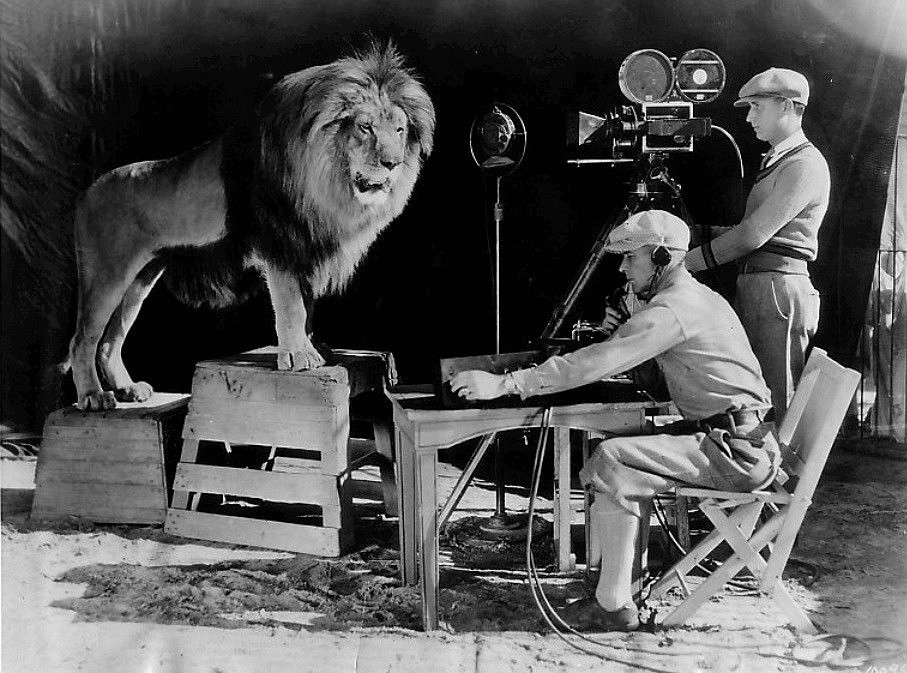
MGM has got a Leo,
But Mama has got a trio.
She is proud,
But says three is a crowd.
—‘Triplets’, The Band Wagon, Howard Dietz/Arthur Schwartz
A roaring lion ensconced in scrolls of celluloid bearing the Latin motto ‘Ars Gratia Artis’. Below it, a comedy mask framed by laurel leaves. And arcing above it all, the words Metro Goldwyn Mayer.
One of the most famous in American cinema, the MGM logo, featuring the studio’s mascot, Leo the Lion, is the stamp of quality that has introduced everything from Ben-Hur (both 1925 and 1959) to The Wizard of Oz (1939).
Part of its fame is due to its familiarity. MGM’s logo has remained remarkably consistent over the decades, especially compared to other major studios like Universal, and audiences have seen its lion roar hundreds of thousands of times. So, in celebration of the studio’s centenary this month, I’ve decided to put MGM’s logo in the spotlight.
Before he became the MGM lion, Leo was the Goldwyn one. Most sources credit Howard Dietz (of Dietz and Schwartz fame) with choosing a lion as the mascot for Goldwyn Pictures in 1916. Alongside his career as a lyricist and librettist, Dietz handled publicity for Goldwyn Pictures and selected a lion in honour of Columbia University, where he’d studied journalism. After Goldwyn merged with Metro Pictures and Louis B. Mayer Pictures to form Metro-Goldwyn-Mayer, Dietz stayed on with the studio, eventually becoming Vice President in Charge of Publicity in 1942, a position he would hold for the next decade and a half. He is also credited with choosing ‘Ars Gratia Artis’ (‘Art for Art’s Sake’) as the Goldwyn Pictures motto, which would be adopted by MGM as well.
While the names of the first two lions in Goldwyn’s logos have been lost to time, the first lion to appear in an MGM one was Slats, who introduced all of the studio’s black and white films from 1924 to 1928. (He first appeared at the beginning of He Who Gets Slapped, a 1924 thriller starring Lon Chaney, Norma Shearer and John Gilbert.) Slats is the only MGM lion who doesn’t roar—talkies and the recorded sound which made them possible wouldn’t become all the rage until 1927.
Slat’s successor, Jackie, was one of the studio’s longest serving mascots, appearing in all of MGM’s black and white films between 1928 and 1956. He was the first to audibly roar, roaring thrice before looking off to the side. Here he is in a publicity still alongside Greta Garbo, who would rather be absolutely elsewhere:
Jackie also had an acting career, appearing in more than 100 films, including Johnny Weissmuller’s Tarzan series.
Next came Tanner, who introduced MGM’s Technicolor films from 1934 to 1956. He’s the lion I tend to think of first, since his tenure coincided with the heyday of the Freed Unit and the release of many of the musicals I love.
His time in the spotlight also included the studio’s shift from displaying its name in a framed box underneath the laurels to the more familiar arc above the celluloid strips.
MGM’s eighth lion is the current incumbent and by far the longest running, having begun his tenure in 1957. He is also the only lion to actually be named Leo. In 1965, the studio recruited the brand consultants Lippincott & Margulies to update the logo and the result was the stylized lion: a rather dull graphic of a lion’s head on a blue background. This lion appeared at the beginning of 2001: A Space Odyssey and The Subject Was Roses (both released in 1968) before the studio thankfully reverted to Leo. (The stylized lion has since been adopted by the casinos that bear MGM’s name, but no longer have anything to do with the studio.) MGM also released a special version of Leo’s logo to celebrate its golden anniversary in 1974:
Naturally, MGM’s logo has been imitated and parodied many times, including by the studio itself. The re-release of A Night at the Opera (1935) featured the Marx Brothers in place of Jackie. Harpo’s roars are, of course, silent:
Jerry the Mouse roars at his mouse hole in the 1961 cartoon Switchin’ Kitten. In a 1967 episode of The Avengers, deranged filmmakers kidnap Mrs. Peel and force her to star in their new production. When her face is framed by their studio’s logo, she roars playfully. And The Great Muppet Caper (1981) opens with Animal in Leo’s place. He takes the concept of scenery chewing quite literally:
In 2021, Leo went CGI and the results haven’t been pretty. Once your eyes register that he’s artificial, it’s impossible to ignore—yet another reminder that we’re currently drowning in a sea of ill-conceived, poorly-rendered computer graphics.
At least MGM still has a Leo, who’s been roaring for 100 years. Here’s to 100 more.

Leave a Reply